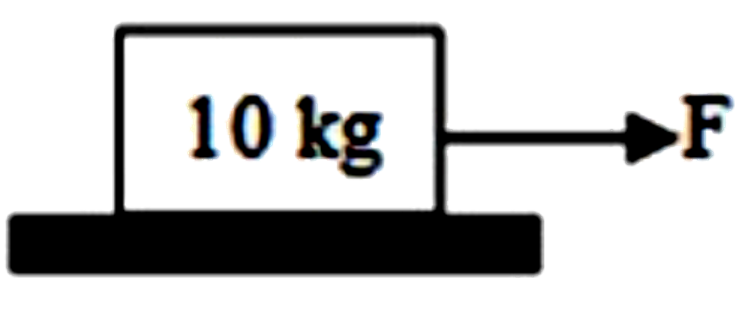A pulley, with a rotational inertia of about its axle and a radius of 10 cm, is acted on by a force applied tangentially at its rim. The force magnitude varies in time as , with F in newtons and t in seconds. The pulley is initially at rest. At t = 3.0 s what are its (a) angular acceleration and (b) angular speed?
To solve the problem step by step, we will find the angular acceleration and angular speed of the pulley at t = 3.0 seconds.
Given Data:
- Moment of inertia of the pulley, I=1.0×10−3kg m2
- Radius of the pulley, R=10cm=0.1m
- Force acting on the pulley, F(t)=0.50t+0.30t2
Step 1: Calculate the Torque
The torque τ acting on the pulley is given by the formula:
τ=F⋅R
Substituting the expression for F(t):
τ(t)=(0.50t+0.30t2)⋅0.1
τ(t)=0.05t+0.03t2N m
Step 2: Relate Torque to Angular Acceleration
According to Newton's second law for rotation:
τ=I⋅α
Where α is the angular acceleration. Therefore, we can write:
I⋅α=0.05t+0.03t2
Substituting I=1.0×10−3:
1.0×10−3⋅α=0.05t+0.03t2
Solving for α:
α(t)=0.05t+0.03t21.0×10−3
α(t)=50t+30t2rad/s2
Step 3: Calculate Angular Acceleration at t=3.0s
Now, we substitute t=3.0 seconds into the expression for angular acceleration:
α(3)=50(3)+30(32)
α(3)=150+30(9)
α(3)=150+270=420rad/s2
Step 4: Calculate Angular Speed
To find the angular speed ω at t=3.0s, we need to integrate the angular acceleration over time. Since the pulley starts from rest, we have:
ω(t)=∫t0α(t′)dt′
Substituting α(t):
ω(t)=∫t0(50t′+30t′2)dt′
Calculating the integral:
ω(t)=(25t′2+10t′3)t0
Now substituting t=3.0:
ω(3)=25(32)+10(33)
ω(3)=25(9)+10(27)
ω(3)=225+270=495rad/s
Final Answers:
(a) Angular acceleration at t=3.0s is 420rad/s2.
(b) Angular speed at t=3.0s is 495rad/s.
- Moment of inertia of the pulley, I=1.0×10−3kg m2
- Radius of the pulley, R=10cm=0.1m
- Force acting on the pulley, F(t)=0.50t+0.30t2
The torque τ acting on the pulley is given by the formula:
τ=F⋅R
Substituting the expression for F(t):
τ(t)=(0.50t+0.30t2)⋅0.1
τ(t)=0.05t+0.03t2N m
According to Newton's second law for rotation:
τ=I⋅α
Where α is the angular acceleration. Therefore, we can write:
I⋅α=0.05t+0.03t2
Substituting I=1.0×10−3:
1.0×10−3⋅α=0.05t+0.03t2
Solving for α:
α(t)=0.05t+0.03t21.0×10−3
α(t)=50t+30t2rad/s2
Now, we substitute t=3.0 seconds into the expression for angular acceleration:
α(3)=50(3)+30(32)
α(3)=150+30(9)
α(3)=150+270=420rad/s2
To find the angular speed ω at t=3.0s, we need to integrate the angular acceleration over time. Since the pulley starts from rest, we have:
ω(t)=∫t0α(t′)dt′
Substituting α(t):
ω(t)=∫t0(50t′+30t′2)dt′
Calculating the integral:
ω(t)=(25t′2+10t′3)t0
Now substituting t=3.0:
ω(3)=25(32)+10(33)
ω(3)=25(9)+10(27)
ω(3)=225+270=495rad/s
(a) Angular acceleration at t=3.0s is 420rad/s2.
Topper's Solved these Questions
- BOOK - RESNICK AND HALLIDAYCHAPTER - RIGID BODY DYNAMICS - IEXERCISE - PRACTICE QUESTIONS (SINGLE CORRECT CHOICE TYPE)43videos
RIGID BODY DYNAMICS - I
- BOOK - RESNICK AND HALLIDAYCHAPTER - RIGID BODY DYNAMICS - IEXERCISE - PRACTICE QUESTIONS (MORE THAN ONE CORRECT CHOICE TYPE)7videos
RIGID BODY DYNAMICS - I
- BOOK - RESNICK AND HALLIDAYCHAPTER - RIGID BODY DYNAMICS - IEXERCISE - CHECKPOINT18videos
RIGID BODY DYNAMICS - I
- BOOK - RESNICK AND HALLIDAYCHAPTER - RELATIVITYEXERCISE - PRACTICE QUESTIONS (Integer Type)5videos
RELATIVITY
- BOOK - RESNICK AND HALLIDAYCHAPTER - RIGID BODY DYNAMICS-IIEXERCISE - PRACTICE QUESTIONS (Integer Type)2videos
RIGID BODY DYNAMICS-II
Similar Questions
Only one force is acting on a 2.8 kg particle-like object whose position is given by x=4.0t−5.0t2+2.0t3, with x in meters and t in seconds. What is the work done by the force from t=0 to t=6.0 s ?
View SolutionA force F=2t2 is applied to the cart initially at rest. The speed of the cart at t = 5 s is -
 View Solution
View Solution
Knowledge Check
- Question 1 - Select One or More
A force given by the relation F = 8t, (F in Newton and t in sec.) acts on a body of mass 2kg. Initially at rest. Choose the correct option.
APower of force is continuous increasing.BThe work done by this force on the body during first 2 seconds of its motion is 64 J.CVelocity at 2 seconds after beginning of motion is 8 m/s.DPower of force is constant. - Question 2 - Select One
A block of mass m at rest is acted upon by a force F for a time t. The kinetic energy of block after time t is
AF2t2mBF2t22mCF2t23mDFt2m - Question 3 - Select One
A block of mass m at rest is acted upon by a force F for a time t. The kinetic energy of block after time t is
A2 FtmB2FtmCFtmDF2t22m
The acceleration of a particle varies with time t as
a=t2+t+2
where t is in seconds.
The particle starts with an initial velocity v-3m/s at t=0. find the velocity of the particle at the end of 5s.View SolutionA wheel with a rotational inertia of 0.50kg⋅m2 about its central axis is initially rotating at an angular speed of 15 rad/s. At time t = 0, a man begins to slow it at a uniform rate until it stops at t = 5.0 s. (a) By time t = 3.0 s, how much work had the man done? (b) For the full 5.0 s, at what average rate did the man do work?
View SolutionForce applied on a body is given by ltbygt F=(3t2−2t+10)N where t is in seconds. Find impulse imparted in t=0 to t=2 sec.
View SolutionA hollow sphere of mass 1 kg and radius 10 cm is free to rotate about its diameter. If a force of 30 N is applied tangentially to it, its angular acceleration is (in rad/s2)
View SolutionThe angular displacement of a particle is given by θ=t3+2t+1, where t is time in seconds. Its angular acceleration at t=2s is
View Solution

